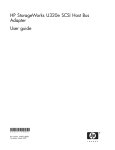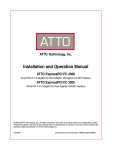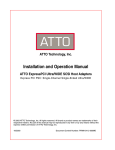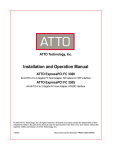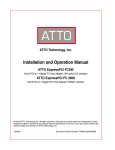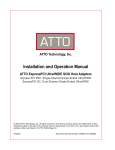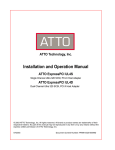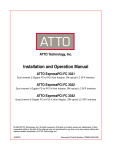Download ATTO EPCI-UL4S Specifications
Transcript
ATTO ExpressRAID Installation and Operation Manual RAID Level 0 Software for Windows® © 2003 ATTO Technology, Inc. All rights reserved. All brand or product names are trademarks of their respective holders. No part of this manual may be reproduced in any form or by any means without the express written permission of ATTO Technology, Inc. 7/2003 Document Control Number: PRMA-0123-000MD Contents 1 RAID Overview ..................................................................................1 RAID Level 0 ATTO ExpressRAID Advantages 2 Installing ExpressRAID ......................................................................3 Installation requirements ATTO Recommendations Installation instructions 3 Using ExpressPCI Utilities .................................................................5 4 Creating a RAID 0 Group ....................................................................7 5 Managing RAID Groups ......................................................................9 6 Benchmarking Drives .........................................................................11 7 Troubleshooting ..................................................................................13 Appendix A: Glossary ...........................................................................i Appendix B: SCSI Host Adapter Selection Guide ...............................iii Appendix C: Fibre Channel Host Adapter Guide ................................iv Appendix D: Contact ATTO Technology, Inc. .....................................v 1 RAID Overview Originally Redundant Array of Inexpensive Disks, now Redundant Array of Independent Drives, RAID is a storage system using multiple disk drives. ATTO ExpressRAID creates virtual disk arrays on physical drives to increase capacity and performance. RAID (Redundant Array of Independent Disks) is a storage system using multiple disk drives to increase capacity and performance. Large amounts of data can be supported over many smaller drives when the drives are combined into one large “virtual” drive. Management is easier because, instead of several drives to consider when deploying data as in a JBOD (Just a Bunch of Disks) configuration, the system only has one address or LUN on a storage bus or network. RAID overlaps disk seeks, minimizing aggregate seek time delays for the storage group as a whole. data are written in equal, short operations to each member of the RAID group in turn so that when the first member of a group begins writing to disk, the second member is available to take data. This continues until the last member of a group is writing to disk, and the first member of a group is ready for data. RAID Level 0 RAID Level 0 is commonly used when performance is more important than data-protection. RAID Level 0, also called striping, is accomplished by mapping data across several disk drives. A single, larger drive is created from several smaller ones. Data is stored onto the physical drives in consecutive “stripes,” defined by the interleave setting in the RAID application. Files that are larger than the interleave size are distributed sequentially across the disk drives in the array. Because data is spread across several drives, the actual throughput is a function of the aggregate performance of all the drives in the stripe group instead of just a single drive. Throughput is equal to the number of drives times the speed of the slowest drive in the stripe set. You should strictly follow a backup policy to protect data stored on RAID 0 volumes. ATTO ExpressRAID Advantages ATTO provides a disk striping method that is implemented at the HBA driver level. The support exists in the Windows driver, the BIOS driver and the DOS driver. The ATTO disk striping provides the following features: ❖Supports removable devices Removable Drives report their presence during any bus scan as long as they are powered up, even without media present. Some pseudo-removable drives, however, do not report their presence unless they are spun up. Once Windows sees a drive at a particular bus/ID combination, Disk Manager will always report that drive as being there. The ATTO striping code will report all removable drives to Windows so that all removable drives will have a drive letter assigned, even when a stripe set is in the removable drives. The ATTO striping driver will intercept I/O to any drive that is a member of an ATTO stripe group. If the drive is the primary stripe member then the I/O will be performed against the stripe group. If the drive is not the primary and it is a removable drive, the ATTO stripe driver will return an error indicating MEDIA not available. This mechanism retains the drive mapping assigned by the initial scan. If the removable media is replaced with a non-striped set of media the system will be able to have direct access to the media. The ATTO striping driver will recognize the fact that media has changed in removable drives.The driver will then institute a rescan of all removable drives that it controls. Any changes to primary drives and stripe groups will be recorded in the driver. The reconfiguration of the removable drives is dynamic and does not require Disk Administrator to be run. ❖Optimizes SCSI requests. The maximum number of SCSI I/O requests generated is given by the number of disks in the stripe group since the HBA driver has access to the scatter gather information. For example, to satisfy a 1 megabyte I/O request to a pair of striped drives with an interleave of 64KB, the ATTO driver will generate 2 SCSI requests. 1 data will be lost. The stripe group can only be accessed with a supported driver. Stripe interleave defines how many logical blocks are used from one drive in the stripe before the next drive’s blocks are used. An interleave size of 64KB (default size) indicates that 64KB of data will come from one drive and the next 64KB will come from the next drive. Therefore, performance optimization attained with striping will only occur when the read or write command is requesting more than 64KB of data. The size of the stripe interleave should be matched to the average size of the read and write commands. Windows OS RAID cannot vary the interleave from 64 KB, which may not be optimum for your application. ❖An ATTO stripe group is recognized under BIOS and DOS environments, enabling the boot drive to be a stripe group. optimal interleave = average transfer size # drives in RAID set ATTO striping provides interleave sizes from 2KB to 512KB: default is 64KB. The optimum interleave size is best determined by trial and error. An interleave size should be chosen and then tested via a benchmark program or by actual tests of the system. Generally speaking, the recommended interleave is equivalent to the average transfer size divided by the number of drives in the stripe set: NOTE ATTO ExpressPCI Ultra 320 and Ultra3/UltraWIDE drivers created before version 1.02 and 1.68, respectively, only supported interleave sizes up to 64KB. If you create a stripe group with an interleave size greater than 64KB with an unsupported version, the stripe group will be inaccessible and the driver will report that members are missing from the stripe group. Do not repair the stripe group with the RAIDUTIL.EXE program or all RAID overview ❖Increased interleave size, from 2KB to 512KB ATTO drivers support striping consistently for all operating systems by combining drives rather than partitions.You may boot the system off a striped set of drives and all operating systems will be able to access the striped drives. ATTO drivers support striping at the miniport driver level in Windows by detecting composite drives during the initial power-on bus scan. During this scan, composite drives are reported to the system only on the last target ID of the stripe group. The miniport driver intercepts any SCSI command sent to the composite drive reported on the highest ID and either emulates the command, sends it to whatever drives in the stripe group are required to satisfy the request, or rejects it as an illegal command. Any command sent to one of the other drives in the stripe set is rejected with a SCSI Selection Timeout error. SCSI Inquiry and Read Capacity commands are emulated. Inquiry data is fabricated to indicate a manufacturer ID of ATTO and a device ID of whatever stripe group name was assigned when the group was created. Read/write/verify requests are sent to the drives required to satisfy the request based on the disk address range involved. Commands such as Test Unit Ready and Prevent/Allow media removal are sent to all drives in the group. When an error occurs on any or all drives in a stripe set, the first error which is detected is returned with the command. 120 GB Disk Drive 120 GB Disk Drive 360 GB Virtual Stripe Group ExpressRAID software presents one virtual drive while routing data to three physical drives 120 GB Disk Drive Example of a 3-drive stripe group created by ExpressRAID 2 2 Installing ExpressRAID ATTO ExpressRAID supports Windows® NT, 2000 and XP operating systems. Installation requires basic hardware, the ATTO Technology CD or a download from our website, some basic understandings of your operating system and some possible adjustments and considerations. Installation requirements To successfully install and use your ExpressRAID software, you will need: ❖One or more ATTO ExpressPCI host adapters ❖2 or more hard drives ❖Working knowledge of the Microsoft operating system ❖Microsoft operating system documentation ❖A fully operational computer with all devices installed and identified, and with an ExpressPCI host adapter successfully installed. ❖Your complete ExpressRAID product. ATTO Recommendations Where to install ATTO ExpressRAID may be installed on your desktop or enabled in the ATTO ExpressPCI host adapter ROM. ATTO recommends that you install ATTO ExpressRAID on your desktop for easiest access. If you plan to boot from a stripe group and there is a disk error, you may want to install ATTO ExpressRAID in the host adapter ROM so that you can delete the stripe group in the ROM. The desktop version does not allow you to access or alter an erroneous stripe group. Note: the procedures to create an ATTO ExpressRAID level 0 array will differ based upon whether you are planning to boot from and install your operating system on the array, or whether you will be creating an array for inclusion to a pre-existing fully operational computer with an operating system installed. 3 ATTO Technology ExpressRAID for Windows Although RAID 0 volumes can be created between different types and models of drives, use similar types/models to ensure the access time of the array will be equal to the average access time of a single drive rather than the access time for the slowest drive in the array. Maximum partition size Some operating system file systems impose maximum partition sizes. For example, the DOS FAT file systems limits the maximum partition size to 2 GB, while the Windows NT FAT file system allows up to a 2 Exabytes partition to be created. Formatting with NTFS allows much larger partition sizes. It is important to research the limitations of your operating system file system before attempting to create your drive array. Maximum number of drives A maximum of 32 drives in any one stripe group can be used. Maximum performance For maximum performance, use dual channel host adapters with drives equally distributed across busses.For the absolute highest performance using SCSI, connect each of the drives to be striped to a separate ATTO ExpressPCI SCSI-3 host adapter. Multiple host adapters increase performance by allowing data to be transferred to all striped drives simultaneously. Third Party SCSI adapters ATTO ExpressRAID will only function with drives attached to ATTO ExpressPCI host adapters. Any drives connected to third party host adapters will not be available for selection when building array groups through ATTO ExpressRAID. DOS prompt for non-Windows systems When creating and deleting stripe groups for any operating system other than Windows 2000 or Drive types/models Installation instructions Windows NT, 2000 and XP operating systems 1 Insert the ATTO ExpressRAID CD in the drive slot of the computer. 2 From the Install pop-up window, select Continue. 3 Select the continue button in the Directory pop up window. 4 On the ATTO ExpressRAID Setup screen, select Continue. 5 Select Continue if you wish to use the default directory, or change the location, then select Continue. 6 The installation program will copy the ATTO ExpressRAID program to the directory you selected, create a new group to contain all of the program icons, and create icons for the utilities and Readme files. 7 Please take a moment to review the Readme files. 8 Your installation is now complete. See Chapter 4 for information on how to create ATTO ExpressRAID arrays for your operating system. Installation Windows NT, you must run all ATTO ExpressPCI/ATTO ExpressRAID utilities from a true DOS prompt only, not a DOS window. Uses Use RAID 0 in environments that demand high I/O rates such as video production and editing, image editing, and pre-press. Digital video If you are using ATTO ExpressRAID in a digital video environment, you will want to set your interleave setting to 64K. You may proceed to perform benchmark testing or run a test capture to fine tune your interleave setting. Upgrading ATTO ExpressRAID To upgrade ATTO ExpressRAID, you must also update all operating system and ATTO ExpressPCI drivers and reflash the ATTO ExpressPCI FC host adapter. The operating system drivers are an integral part of ATTO ExpressRAID and are all included on your ATTO ExpressRAID CD. Back ups Since RAID 0 does not provide fault tolerance, establish a backup policy to protect data stored on RAID 0 volumes. Note: You do not have to enable ExpressRAID in the ExpressPCI ROM because it will be automatically enabled once you have created the first stripe group. 4 3 Using ExpressPCI Utilities ATTO ExpressPCI Utilities supports Windows® NT/2000/XP and Windows 95/98. Additional support is provided through the ATTO hardware BIOS driver (BOOTROM.sys for Ultra3, Ultra/WIDE and Fibre Channel adapters, BOOTROM2.sys for Ultra320 adapters). The ExpressPCI Utilities installation utility will automatically launch when the ATTO ExpressPCI CD-ROM is inserted. 1 The main installer screen presents four options. Click on the appropriate button. Install SCSI Software (ExpressPCI PSC, PSCd, DC, UL3S, UL3D) Install SCSI Software (ExpressPCI UL4S, UL4D) Install Fibre Channel Software Exit. 2 Selecting any of the three Install … options brings up another options window. Some options may be unavailable, depending on the type of installation. Click on the appropriate button to begin the desired task. Create Standard Driver Installation Floppy Create Microsoft Certified Driver Installation Floppy Install ATTO Tools Install Adobe Acrobat Browse ATTO Manuals 3 Depending on your selection, you will be presented with additional on-screen instructions. Follow these instructions to complete the task. The appropriate utilities will be installed on your system. 4 Click the Exit button when you are finished with the installation utility. 5 ATTO Technology ExpressRAID for Windows ATTO provides a full suite of configuration tools and supplemental utilities to enhance the performance of the ExpressPCI host adapters. ❈Host adapter NVRAM settings may be changed using the appropriate utility. Refer to ATTO ExpressPCI Utilities Installation and Operation manual for information on using these utilities. During system boot, press [CTRL-F] to modify NVRAM settings on ExpressPCI Fibre Channel host adapters During system boot, press [CTRL-Z] to modify NVRAM settings on ExpressPCI SCSI host adapters. In Windows NT/2000/XP, run the SCSI Util application to modify NVRAM settings on ExpressPCI SCSI host adapters. In Windows 2000/XP, run the ATTO ExpressPCI Configuration Tool to modify NVRAM settings on ExpressPCI Ultra 320 SCSI and Fibre Channel host adapters. This application does not work with ATTO Ultra3 and Ultra/WIDE host adapters. ❈Monitoring system performance (Bench32), configuring mode pages (Alamode), validating SCSI connections (SCSIDV), masking Fibre Channel LUNs (LUN Mask) and other specialized functions are also supported by ExpressPCI host adapters. Refer to the appropriate chapter of this manual for information on these utilities. 6 4 Creating a RAID 0 Group ATTO ExpressRAID may be installed on your desktop or enabled in the ATTO ExpressPCI host adapter ROM. ATTO recommends that you install ATTO ExpressRAID on your desktop for easiest use. If you plan to boot from a stripe group and there is a disk error, you may want to install ATTO ExpressRAID in the host adapter ROM so that you can delete the stripe group in the ROM. The desktop version does not allow you to access or alter a stripe group. 15 Exit the RAID Configuration Utility and reboot your system. 16 The RAID group will appear as a single drive. Use Disk Administrator to partition and format the RAID group as you would any drive. Install the desktop version for ease of use. From the an existing Windows 2000/XP or Windows NT system 1 From the desktop, select the Start icon. 2 From the pop-up menu, select Programs. 3 From the pop-up menu, select ATTO ExpressRAID. 4 The RAID configuration screen appears. Maximize the application window. 5 From the ExpressPCI ROM for Windows 2000/XP or Windows NT Note: If a stripe group or your Windows NT environment has become corrupted, this procedure must be used to recover. If the stripe group has a disk error, you may have to low level format the drive. 1 Click in the white area of the Stripe Group window to select it 6 From the Edit menu, select Insert. 7 Enter a stripe group name and click OK. 8 The Members window will be selected automatically. 9 From the Edit menu select Insert. Enable the RAID capability in the ATTO ExpressPCI host adapter ROM a. b. Insert ATTO ExpressRAID CD into CD drive and a blank floppy disk into the a drive. c. e. 11 Repeat step 10 until you have selected all of the disks you wish to include in your RAID group. g. Place floppy into floppy drive. h. Follow on-screen instructions. i. After flash completion the following message will appear: RAID has been enabled for your adapter(s). Remember to Save Parameters when you exit. j. Save and exit. 13 From the interleave field, select one of the interleave sizes for your RAID group. Choices range from 2 to 512KB. 7 ATTO Technology ExpressRAID for Windows At ATTO banner press CNTL-F to enter setup utility. f. Select Update Flash. 12 Verify that all the disks you have selected appear in the members window. Note: Save the RAID group before exiting the program. The software will NOT prompt you to save the group if you exit through the application icon in the upper left hand corner of the screen. Run makedisk.bat file. d. Reboot system. 10 Select the disk you wish to include in your RAID group, then select OK. 14 From the Group menu, select Save to save your group. Boot into Windows 2000, Windows NT or Windows 9X. 2 Boot your computer 3 Press Ctrl F to launch the ATTO ExpressPCI FC Utilities. Main Menu 1. Configure Adapter Channels 2. Selectable Boot Device 3. Reset All Parameters 4. Display Device List 5. Format Disk Drives 6. Configure Stripe Groups 7. Update Flash ROM 8. Save Parameters and Exit 9. Discard Changes and Exit 4 Using the up arrow and down arrow keys, go to the Configure Stripe Groups option and press Enter. 5 Press the Insert key to make a stripe group. 6 Enter a group name in that field. 7 Advance to the Interleave field by using the down arrow key and enter an interleave. The default value is 65536. 8 Advance to the No Units device field by using the down arrow key. 9 Press the Insert key for a list of available disk drives. 10 Select a drive using the up and down arrow keys and press Enter. The drive will appear in the Group Members section of the Stripe Groups window. 11 Repeat steps 5 to 10 to include additional disk drives in the stripe group. 12 After you have selected all of the drives you wish to include in your stripe group, press the Enter key and the stripe group window appears Group Members Group name Number of Units ATTO RAID 2 Size Status 17,783,168 OK 13 Press Esc to return to the ATTO ExpressPCI utilities main menu. 14 Using the up and down arrow keys, go to the Save Parameters and Exit option and press Enter. 15 Format and partition the drive as you normally would. 8 5 Managing RAID Groups You can create, reconfigure, or delete stripe groups from the Configure Stripe Groups window. Damaged stripe groups can also be repaired by reconfiguring them, but all data will be lost. From the Main Menu, highlight Configure Stripe Groups and press Enter. You can select an existing stripe group and reconfigure it by pressing [Enter] or delete it by pressing [Del]. Pressing [Ins] will take you to a blank Edit Stripe Group window. 2 When you press [Ins] while in the drive list on the New/Edit Stripe Group window, the available drive list appears. All disk drives not currently members of stripe groups will be shown. a. New/Edit Stripe Group Window 1 [Enter] - Accept group as displayed a. When the window first appears, the cursor will be on the Group Name field. Enter a unique stripe group name of up to 32 characters. b. The Stripe Interleave can be set to 2048, 4096, 8192, 16384, 32768, or 65536 bytes. c. If you press the [Enter] key while on this screen and the stripe group is not valid, a message box will appear. d. If there is a blank or non-unique name in the Group Name field, the cursor will be placed on this field when you acknowledge the message box. e. If there are fewer than two members in the stripe group, the cursor will be placed in the drive list after the message box is closed. f. If the stripe group existed before the configuration utility was started and you change anything other than the group name, a warning message will appear when you press [Enter]. You can decide to cancel the changes by pressing [n] or accept the changes by pressing [y]. 2 The [Ins] and [Del] keys are not available (and help text does not appear for them) until the user goes to the drive list. 3 [Esc] - Exit window, discard changes Add New Stripe Group Member 1 Select a device and press [Enter] or press [Esc] to cancel. 9 ATTO Technology ExpressRAID for Windows If you select a drive which has partitions defined, a message will warn you when you try accept the drive into the stripe group. b. You may select drives of different sizes into a stripe group but the total amount of space in a stripe group is limited to the number of drives multiplied by the size of the smallest drive in the group. Therefore, if you choose to stripe a 2 GB and a 4 GB drive, the resulting stripe group will contain only 4 GB, and 2 GB of disk space will be wasted on the second drive. c. Even if you select drives of exactly the same size, the total stripe group size displayed in the Configure Stripe Groups window may be slightly less than the sum of the sizes of the drives because the software must truncate each drive so that it consists of an integral number of Stripe Interleaves. Partition and Format Stripe Groups Now that you have a stripe group, your system recognizes the group as a single drive that must be partitioned and formatted like any other drive. Windows 2000/Windows NT Use Disk Administrator to partition the drive as you normally would partition and format any drive. For additional help, refer to your operating system’s instructions. Windows 95 After building your array groups, use MS-DOS Fdisk command to prepare your partitions. Use the format command to initialize the partition so that it is capable of storing data. For more help, refer to your operating system’s instructions. Deleting an Array 1 2 Press [Esc] to exit to the main menu 3 Choose Save Parameters and Exit for a system reboot. To delete an array you have already created, highlight it in Stripe Group Window and press [Delete]. 10 6 Benchmarking Drives ExpressRAID includes a utility for benchmarking drives. Open the ATTO Disk Benchmark by clicking on the Start button, going to Programs, ATTO Technology and then clicking on Disk Benchmark. Status Bar: ❖Displays information or status of the selected item in the main window. File: ❖New - Creates a new test document. ❖Open - Opens an existing test document. ❖Save - Saves an opened document using the same file name. ❖Save As - Saves an opened document to a specified file name. ❖Resize - Change the size of the window to fit the dialog. ❖Print - Print the active document. ❖Print Preview - Displays the document as it would appear printed. ❖Print Setup - Selects a printer and printer connection. ❖1, 2, 3, 4 - Open previously closed documents. ❖Exit - Ends your Disk Benchmark session. View: ❖Toolbar - Shows or hides the toolbar. ❖Status Bar - Shows or hides the status bar. ❖Scale Factor - Opens the Scale Factor dialog box. Help: ❖Help Topics - Open the Help table of contents. ❖About Bench32 - Display version and copyright information. Toolbar: ❖Page icon - Open a new document. ❖Folder icon - Open an existing document. ❖Disk icon - Save the active document with its current name. ❖Printer icon - Print the active document. ❖Magnifying glass icon - Displays the document as it would appear printed. ❖Arrows icon - Resize the window to fit the dialog. ❖Question Mark icon - Display version and copyright information. ❖Arrow with Question Mark icon - Enter context sensitive help mode. 11 ATTO Technology ExpressRAID for Windows Performing a benchmark test: 1 Select the desired test options from the main window. Drive Select the logical drive to benchmark. A test can be performed on any system drive. Transfer Size Select the range of transfer sizes used for reading and writing data to the test drive. Transfer speeds will be displayed for each size in the range. If the first size is greater than the second size, the test will not be performed for any transfer sizes. Total Length Select the total size of the data file to be created on the test drive. This file is deleted upon completion of testing. Direct I/O If this option is checked, file I/O on the test drive is performed with no system buffering or caching. Combine this option with Overlapped I/O for maximum asynchronous performance. Radio Button Group Three additional options are also available -Overlapped I/O, I/O Comparison, and Neither. Select Overlapped I/O to perform queued I/O. Upon selection, the Queue Depth option appears to select the maximum number of read or write commands that may be executed simultaneously. Select I/O Comparison to compare the data read from the test file to the data written on a per block basis. You can select the data pattern for comparison in the Test Pattern dropdown box that appears. You can also select the Run Continuously option to run the test continuously for a specified number of minutes. The test will stop before the specified time if any errors are detected. Select Neither if you do not want to perform overlapped I/O or I/O comparisons. Three additional fields are provided for informational purposes only: Actual Value: The value read from the file. Stripe Group Expected Value: If the test drive is a stripe group, select its name. The names and quantities of drives in the stripe group will be printed to the Description box. Select << Clear >> to clear the contents of the Description box. The value written to the file. Controlled by Lists all ATTO host adapters on the system that may control the selected drive. Description Enter additional information about the test that can be saved or printed. Be sure to enter additional information after making a selection from the Stripe Group dropdown box, as this will erase the current description. 3 When all selections are made, press the Start button in the main window. The benchmark test will now begin on the selected drive and the Test Results Display at the bottom of the window will be updated. The y-axis of the graph represents the transfer sizes in the selected range and the x-axis represents the transfer speeds in MB/sec. I/O speeds for each transfer size are also displayed textually to the right of the graph in KB/sec. 4 Pressing the Stop button will stop the test. 5 When the test completes, the results can be saved or printed. 6 If the I/O comparison option was selected and errors were not detected, the message “No errors detected” is displayed. 7 If errors were detected, a dialog box will appear to display the errors in a table with the following four columns: Transfer Size: Transfer size at which the error occurred. Buffer Index: Benchmarking drives 2 Log to File: Logs the error table to a (*.log) file and closes the dialog. The file is given the same name as the test file and saved in the same directory. If the test was not previously saved, errors are logged to the generic file Bench32Error.log in the root of the test drive. If the log file already exists, the new errors are appended to the previously recorded errors. This is the only way to save detected errors. They are not saved in the test document file. Performing multiple benchmark tests The ATTO Disk Benchmark supports four command line parameters for uninterrupted testing: testfile: Opens and executes the test named testfile with the extension.bmk or.tst (prior versions of Disk Benchmark). If I/O Comparison is selected, errors will automatically be logged to the appropriate file. Any other errors that occur during testing are logged to this file as well. textfile: Opens the text file named textfile with the extension .bmk or .tst (prior versions of Disk Benchmark). Each test in this list will be opened and executed in order. Stopping one test in the list will prevent further tests from being executed. Error logging is the same as with the command line parameter testfile; however, all errors generated from all tests in the list are logged to one file: textfile.log. /p testfile: Same as testfile, only the test will be printed to the default system printer instead of being executed. /p textfile: Same as textfile, only the tests in the list will be printed to the default system printer instead of being executed. Index into the data block at which the error occurred. 12 7 Troubleshooting Troubleshooting the installation of any new piece of hardware or software can be frustrating. The following suggestions may help if you are having problems installing the ATTO ExpressPCI FC host adapter. ❖Check all cable connections to each device. Verify that all cables are in proper working condition. ❖Make sure that each device is powered up and has completed its self check before booting your machine. ❖Verify that all devices are functional by looking at the activity lights on the drive cases. ❖Reboot your system any time you make changes to the stripe group. ❖As a last resort, you may use the ATTO boot configuration utility to low level format a troublesome device. ❖If you are running Windows NT and the desktop version of ATTO ExpressRAID and encounter a corrupt stripe group or Windows NT failure, you must reboot your machine and use the ATTO ExpressRAID installed the ATTO ExpressPCI host adapter ROM. You cannot alter or modify a malfunctioning stripe group through the desktop version of ATTO ExpressRAID. ❖Compare the termination of your system to the description in the section on termination in your host adapter manual. 13 ATTO Technology ExpressRAID for Windows ❖Verify that all of the devices attached to the ExpressPCI host adapter have unique SCSI IDs. Remember, the ExpressPCI host adapter has a SCSI ID of 7 by default. ❖If the same device shows up at several different SCSI IDs, its SCSI ID is probably set the same as the ExpressPCI host adapter’s SCSI ID or the cable is defective. ❖Verify the external SCSI devices are all plugged into an AC outlet, and are turned on before you power-up your PC. ❖Verify the PCI Bus setup on your motherboard is configured correctly. ❖If you are installing a SCSI boot drive, check your CMOS setup and verify that your DRIVE TYPE is set to NOT INSTALLED. ❖Have you partitioned your drive, and then activated that partition? ❖Did you format the drive for your operating system? ❖If a device does not show up, verify that cables and termination are set properly or lengthen the SCSI Bus Reset Delay. 14 Appendix A Glossary Some common terms used in the storage industry are defined below. More information about Fibre Channel, SCSI and Storage Area Networks is available through the ATTO Technology website (www.attotech.com), the Fibre Channel Industry Association (www.fibrechannel.org), the Fibre Channel Consortium (www.iol.unh.edu/consortiums, click on FC), the SCSI Trade Association (www.scsita.org), and the Storage Area Networking Industry Association (www.snia.org). Term Definition address a specific location in memory ANSI American National Standards Institute asynchronous a method of sending data over a bus in which an initiator sends data then waits for an acknowledgement (ACK) that the data has been received. See synchronous. BER Bit Error Rate: a measure of transmission accuracy; the ratio of bits received in error to bits sent bit Smallest unit of data a computer can process: a single binary digit with a value of either 0 or 1 block a sector of a disk which stores a group of bytes that must be read or written together. Most systems and hard disks use 512 bytes in a block. burst speed maximum speed data can be transferred Byte an ordered set of 8 bits CRC Cyclic Redundancy Check: an error-correcting code which calculates a numeric value for received and transmitted data. If no error has occurred during transmission, the CRC for both received and transmitted data should be the same. destination address a value in the frame header of each frame which identifies the port in the node where the frame is being sent FC Fibre Channel firmware Software stored in read-only memory (ROM) or programmable ROM (PROM). Firmware is often responsible for the behavior of a system when it is first switched on. frame an indivisible unit for transfer of information in Fibre Channel frame header the first field in the frame containing the address and other control information about the frame. full duplex a communication protocol which allows transmission in both directions at the same time half duplex a communication protocol which allows transmission in both directions, but only one direction at a time host a processor, usually a CPU and memory, which communicates with devices over an interface initiator device A component which originates a command JBOD Just a Bunch Of Disks: a storage subsystem using multiple independent disk drives with or without RAID configuration. LUN Logical Unit Number: a SCSI or Fibre Channel identifier of a device originator an initiating device; a component which originates a command partition a logically separate portion of a disk used to allow multiple systems to coexist on a single disk drive. payload the part of the data field in a frame left after optional headers are removed PCI Peripheral Component Interconnect: a bus which allows devices to communicate with the CPU. i ATTO Technology ExpressRAID for Windows Definition RAID Originally Redundant Array of Inexpensive Disks, now Redundant Array of Independent Drives: a storage system spanning multiple disk drives. The following standard RAID specifications will be used here: Glossary Term RAID 0: disk striping in which fixed-length sequences of data are mapped to member disks in a regular rotating pattern. RAID 1: Mirrored arrays: information written to one disk is also written to another simultaneously. Also known as disk shadowing, real-time copy, and t1 copy. RAID 10: Striped array with mirroring receiver the ultimate destination of data transmission; a terminal device SCSI Small Computer Systems Interface: a processor-independent standard for system-level interface between a computer and intelligent devices including hard disks, floppy disks, CD-ROM, printers, scanners, etc. synchronous a way of sending data over a bus in which an initiator sending data does not wait for an acknowledgement (ACK) that the data has been received before sending more data. See asynchronous. Both the initiator and receiver must support synchronous mode. target a device which responds to commands by an initiator topology logical layout of the parts of a computer system or network and their interconnections transfer rate the rate at which bytes or bits are transferred, as in megabytes or gigabits per second. volume a usable quantity of storage composed of one or more partitions residing on one or more physical drives. A standard volume creates a partition on a single drive. ii Appendix B SCSI Host Adapter Selection Guide ATTO Technology offers a number of SCSI and Fibre Channel solutions for storage. The following chart compares the features of ExpressPCI SCSI host adapters. Supported platforms: Sun Solaris; Linux; NetWare; SCO Unix; Windows 2000, 95/98, NT, and Macintosh OS and OS X. Complete RAID packages are also available and include an ExpressPCI SCSI host adapter, ExpressRAID software and appropriate cable(s). Add "-KIT" suffix to host adapter product code (i.e. EPCI-UL3D-KIT) Specific features Single Channel ExpressPCI Ultra 320 Express PCI Ultra 3 Express PCI Ultra Wide 320 MB/sec 160 MB/sec. 40 MB/sec. 64-bit 32-bit 33/66 MHZ 133 MHZ Bus ID support 30 30 15 EPCI-UL4S EPCI-UL3S EPCI-PSC Max. transfer rate LVD HVD Part number Dual Channel--- 2 ExpressPCI Ultra 320 independent channels Max. transfer rate Express PCI Ultra 3 640 MB/sec 320 MB/sec. LVD 64-bit 32-bit 33/66 MHZ 133 MHZ Bus ID support 30 30 EPCI-UL4S EPCI-UL3D Part number iii ATTO Technology ExpressRAID for Windows Appendix C Fibre Channel Host Adapter Guide Each ATTO Technology Fibre Channel host adapter supports the following platforms: Macintosh OS, Windows NT/2000/XP, 95/98, Sun Solaris; Linux; NetWare, and SCO Unix. Complete RAID packages are also available and include an ExpressPCI host adapter, ExpressRAID software and appropriate cable(s). Add “-KIT” suffix to host adapter product code (i.e. EPCI-3300KIT). Fibre Channel ports Optical interface ExpressPCI FCSW Express PCI FC 2600 ExpressPCI FC 3300 ExpressPCI FC 3321 Express PCI FC 3305 1 1 1 2 1 Fixed SW LC Fixed SW LC Fixed SW SC Copper interface HSSDC HSSDC Max. transfer rate 200 MB/sec. full duplex 200 MB/sec. full duplex 400 MB/sec. full duplex 400 MB/sec. per channel full duplex 400 MB/sec. full duplex Class 2 transfers 7 7 7 7 7 7 7 7 7 7 7 7 7 7 7 7 7 7 7 7 7 7 7 7 7 7 7 7 7 7 7 7 7 7 7 500 m 25 m (175 m with MIA) 500 m 500 m 25 m (175 m with MIA) Class 3 transfers Full duplex 66 MHz backward compatible with 33 MHz 64- and 32-bit PCI support ® Windows XP/2000/NT; Windows 95/98; Linux and Macintosh® OS, OS X RAID support Max. cable length Part number EPCI-FCSW000 EPCI-2600-000 EPCI-3300-000 EPCI-3321-000 EPCI-3305-000 Complete RAID packages are also available. To receive the ATTO ExpressPCI host adapter, ExpressRAID software and appropriate cable(s), add “-KIT” to host adapter product code (i.e., EPCI-2600-000-KIT) when ordering. iv Appendix D Contact ATTO Technology, Inc. While we do our best to provide you all the information you will need to use our products, we recognize that additional assistance is sometime required. If you have questions about installing, using or obtaining any of our products, you may contact us at: ATTO Technology, Inc. 155 CrossPoint Parkway Amherst, NY 14068 The information you need to answer your questions may be available 24-hours a day on our web site (http://www.attotech.com). You may also contact our support departments at the following e-mail addresses. Sales Support: [email protected] Technical Support: [email protected] Telephone customer service and sales support is available Monday through Friday between 8 a.m. and 8 p.m. EST at the following numbers: (716) 691-1999 (716) 691-9353 voice fax v ATTO Technology ExpressRAID for Windows
























